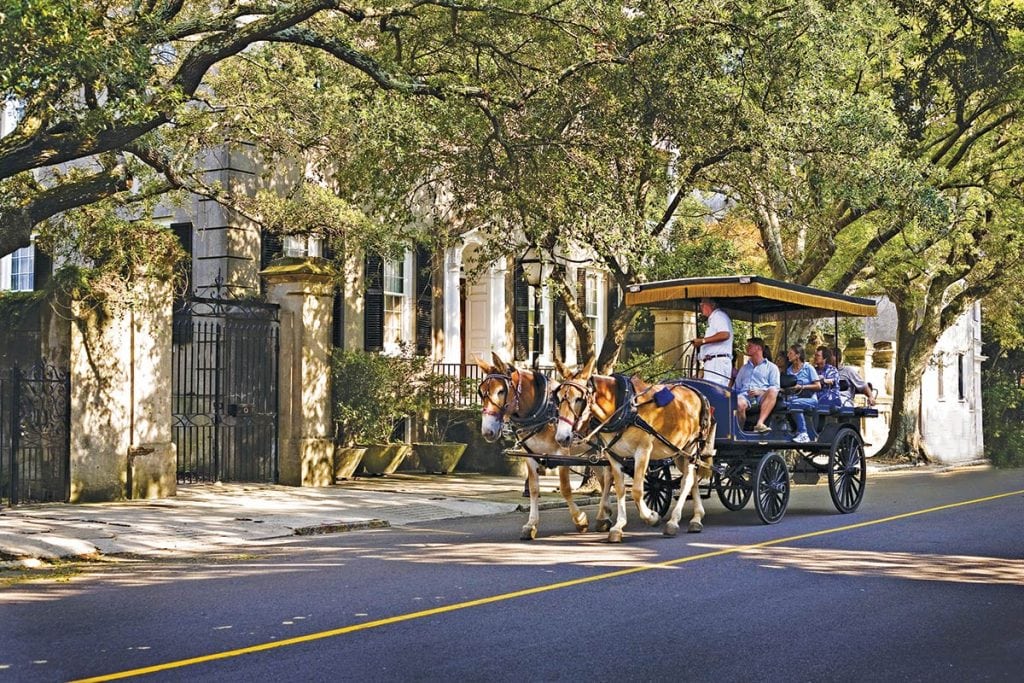The history, well-preserved architecture and mannerly people make Charleston, South Carolina, one of the most adored cities in the world. Locals call it the Lowcountry—because the city is either at or below sea level—or the Holy City since no building can be taller than the tallest church steeple. Charleston’s accolades by well-known travel periodicals include being crowned the “Top Destination in the World,” and for three consecutive years it was named the “Top U.S. City.” Within ten miles of downtown exist three charming beaches: Isle of Palms, Sullivan’s Island and Folly Beach. If the radius is extended by ten miles tack on Kiawah and Seabrook Islands, two world-class golf destinations.
Charleston is the Cooperstown of American history—throw a rock and you’re bound to hit a notable Revolutionary or Civil War landmark. Charleston’s calendar is full with goings-on—sometimes triple booked—so a popular activity for Charlestonians is “staycationing.” April brings four major events, three of which occur on the first weekend of the month: the Family Circle Cup, a WTA Premier Event; the Cooper Bridge Run, the biggest and best organized 10K race in the world; and the Flowertown Festival, one of the largest arts and crafts festivals in the South. A week later is Charleston Race Week, one of the best-known regattas in the country.
To vacation in Charleston and not explore her waterways is just wrong—it’s tantamount to counting your layover in the Atlanta Airport as your one and only visit to the South. Charleston’s waterways are paradise. To the south is the Ashepoo-Combahee-Edisto (ACE) Basin, while to the north is the Cape Romain National Wildlife Refuge. The ACE Basin is the largest estuary on the Eastern Seaboard. Half of the 66,000 acres in the Cape Romain Refuge are ranked as a Class I Wilderness, a designation reserved for the most pristine places. Boat a little further south or north of these areas and you’ll be in one of Charleston’s Sister Cities, Beaufort or Georgetown, the second and third oldest cities in South Carolina, respectively.
[photomosaic type=”rectangular” ids=”4750,4752,4753,4754,4755,4756,4757″ orderby=”rand”]
The Charleston Harbor is a confluence of the Ashley and Cooper Rivers. The Ashley is a Federally designated Scenic River, and boating the thirty miles of black water swamp and tidal waters is an adventure worth planning. Adorning its pluff-mud and oak-tree lined banks are 26 National Historic Places, of which three notable points of interest are pre-Revolutionary era plantations: Drayton Hall, Magnolia Plantation and Gardens, and Middleton Place. Drayton Hall is the oldest unrestored plantation house in America (built in 1742) and considered one of the best examples of Georgian-Palladian architecture in the country. Magnolia and Middleton Plantations have the oldest natural and manicured gardens in America, respectively.
Capers Island is an undeveloped barrier island north of Charleston near ICW Marker 99. During the boating season Capers turns into a boating playground due to its 214 acres of unspoiled beach. A must is to hike through “Boneyard Beach,” a massive graveyard of palms and oaks bleached over time by the harsh marine elements. Camping on the island is permitted year-round.
Foodies will fall in love with Charleston. Year after year its chefs and restaurateurs bring home the coveted James Beard Awards known as “the Oscars of the Food World.” Most of the waterfront restaurants are just east of the city in the towns of Mount Pleasant and Isle of Palms. Locals say nothing is more fun than boating to Morgan Creek Grill, but the food, view and good times on the restaurant’s open-air upper deck is only half the story. The boat ride is worthy of five stars as you idle north on the ICW past prime real estate through the beach towns of Sullivan’s and Isle of Palms.
Less swanky but just as interesting is Goat Island, a two-mile strip of sandy bluff with a row of old, quirky beach cottages set in a thicket of trees. According to lore, a married couple expatriated to the island in 1931 to live among the feral goats. Squatters, the Goat Man and his wife lived out their lives on the island in the buff, bleating at intruders.
You can’t visit Charleston without a trip up Shem Creek, a haven for dolphins and manatees. It winds through Mount Pleasant’s Old Village––one of the most historic and prestigious neighborhoods in Charleston––before spilling into the Harbor. Six restaurants on its banks make it a popular, fun waterfront-dining destination. Near its mouth and behind the old shrimp boat Winds of Fortune is one of the best eateries in Charleston. The Wreck of the Richard & Charlene is exactly what you’d imagine, a hole-in-the-wall serving up fresh local seafood. It’s named after the Richard & Charlene, a derelict North Atlantic trawler that Hurricane Hugo impaled on bare pylons, now the site of the restaurant. To access Shem Creek follow the Mount Pleasant Channel located near the Harbor entrance starting at red and green day-beacons 2 and 7. Beside the channel you’ll get a bird’s eye view of the richest real estate in Charleston, the Harbor homes in the Old Village.
Charleston is a fascinating and constantly evolving city I’m proud to call home. Living here feels like a vacation, and if you’re like me you’ll be happiest while cruising her waterways.
By David Kuczkir, Southern Boating January 2014













